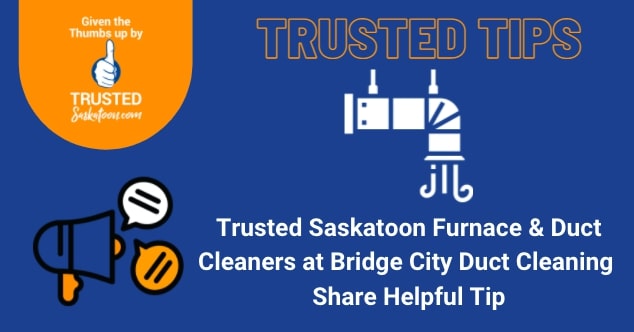Trusted Saskatoon Furnace & Duct Cleaners Bridge City Duct Cleaning provides both residential duct cleaning and commercial duct cleaning and furnace maintenance services. Their team is professionally trained, qualified, bonded, and factory furnace and duct cleaning technicians. In their latest article, they discuss how air duct cleaning is done.

The Steps To How Air Duct Cleaning is Done
Step 1: Inspect The Air Ducts
A simple, visual inspection of the ducts leading to the return and supply registers is important for two reasons. First, it’s a step that you can take yourself to assess the level of buildup in the ducts beforehand and confirm the difference after they’ve been cleaned.
Second, a professional duct cleaning is an opportunity for Bridge City Duct Cleaning to check the ductwork for leaks or, in the case of flexible ducts, kinks. It is also a good time to repair and replace damaged ductwork.
Step 2: Create Negative Pressure
Bridge City Duct Cleaning uses large, portable or truck-mounted vacuum collection devices to suck dust and debris out of your ductwork. However, before turning on the suction and scrubbing the ducts, the technicians must perform preliminary steps.
- First, they hook the vacuum collection device’s large hose to a duct close to the air handler—the heart of your HVAC system. The technician cuts an access hole in the duct, inserts the vacuum hose, and seals where they join as tightly as possible.
(Note that your HVAC system has a supply and a return side—ducts that send treated air into the rooms of the house, and ducts that return air to the air handler. The supply and return sides are separate, and the duct cleaning process is performed on each.)
- Next, the technician will seal each register with an adhesive cover. This is an important step because even an extremely powerful vacuum collection device will not work if the registers in each room of the house are uncovered.
- Once the technician finishes these steps, they turn on the vacuum unit. This step creates negative pressure, and particles inside the ductwork will be sucked into the collection device as they are brushed or blown loose.
Step 3: Agitate The Dust
Once the system is under negative pressure, the technician uncovers each register and cleans each duct. Technicians use rotating brushes, compressed air tools, and simple vacuum cleaners to ensure dust is dislodged and sucked into the vacuum collection device.
Step 4: Clean The Rest Of The System
It is recommended to clean the other components of the HVAC system as well, including the air handler’s blower motor, evaporator coil, and drain pan.
Cleaning these components, along with cleaning or changing the filter, will improve the air quality in your home as well as extend the life and increase the efficiency of your HVAC system.
A Bridge City Duct Cleaning technician will perform the job thoroughly and carefully, ensuring that your ductwork winds up clean and undamaged. A thorough cleaning should take three to five hours and this is how your air ducts are cleaned.